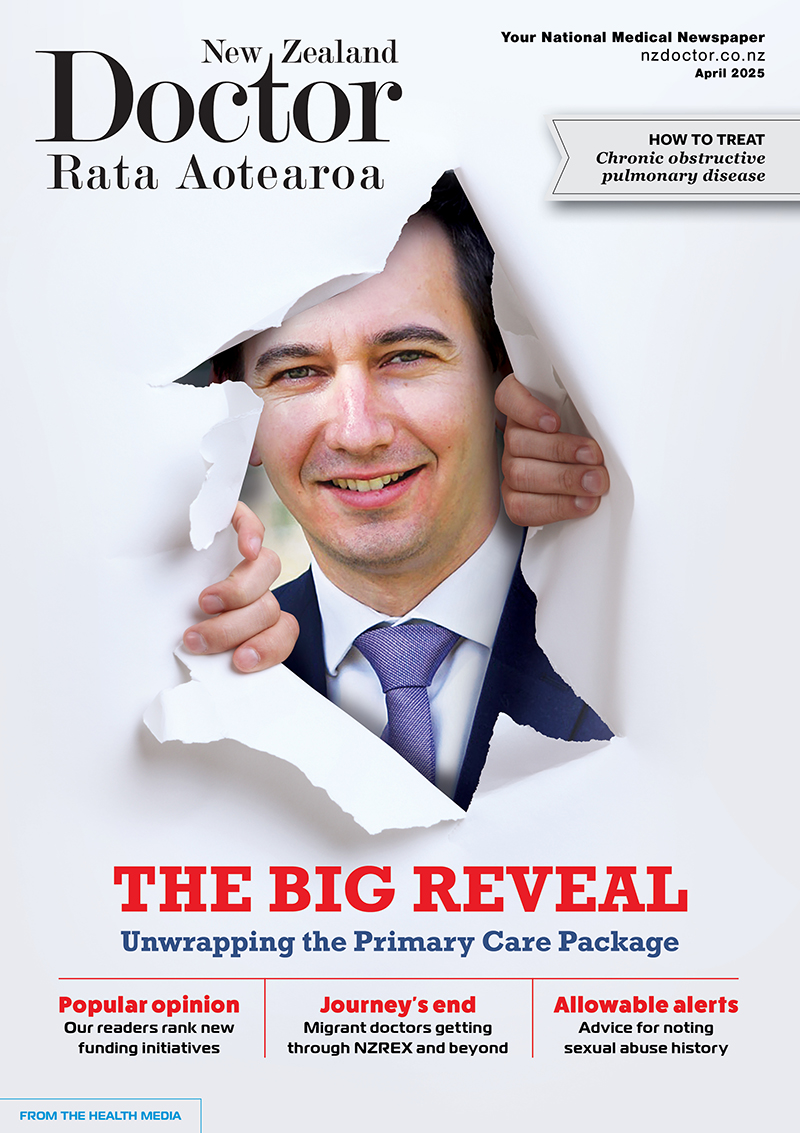Respiratory physician Lutz Beckert considers chronic obstructive pulmonary disease management, including the prevention of COPD, the importance of smoking cessation and pulmonary rehabilitation, and the lifesaving potential of addressing treatable traits. He also discusses the logic of inhaler therapy, moving from single therapy to dual and triple therapy when indicated, as well as other aspects of management
Health Infrastructure Plan released
Health Infrastructure Plan released

Health Minister Simeon Brown has today released New Zealand’s first-ever Health Infrastructure Plan, setting out a national, long-term approach to renewing and expanding the country’s public health facilities.
“This is a first for New Zealand – a single, long-term plan that lays out a clear pipeline for health infrastructure,” Mr Brown says.
“Our health system is under significant pressure from ageing infrastructure that hasn’t kept pace with the needs of a growing and ageing population.
“The average age of our public health estate – 1,274 buildings across 86 campuses – is around 47 years. This is creating some significant challenges.
- Buildings that require major remedial work to avoid service disruption.
- Facilities with poor seismic ratings or serious compliance risks.
- Outdated infrastructure that unable to support modern models of care.
“The state of our health infrastructure is not a new challenge; it is a problem that has developed over multiple decades. Addressing it requires a long-term plan to both renew existing capacity, and invest in new facilities, to meet future demand and ensure New Zealanders continue to receive high-quality care.
“The Health Infrastructure Plan identifies the more than $20 billion investment required to meet future health needs and introduces a more efficient way of delivering large hospital projects, called ‘Building Hospitals Better’.
“Instead of building single, large-scale structures, the plan proposes a staged approach – delivering smaller, more manageable facilities in phases. This will mean patients benefit from modern healthcare environments sooner, while providing greater certainty around delivery timeframes and costs.
“The plan outlines a comprehensive, phased programme of hospital and facility developments across the country to be delivered in three to four stages. This includes major new builds and expansions across the country, featuring new acute services buildings, inpatient units, expanded emergency departments and wards, and upgraded facilities.
“It also includes the planning and initial build of the recently announced new hospital in South Auckland – a critical investment for one of the country’s fastest-growing regions.
“The plan is underpinned by the National Clinical Service and Campus Plan, which seeks to deliver more health services in the community and reduce demand on hospitals.
“Building new ambulatory hubs in population centres means services such as radiology, oncology, dialysis, and day-stay surgeries can be delivered closer to the community, while also reducing capital investment costs.”
Each project in the pipeline will require a business case and will go through normal funding approval processes by Cabinet.
“While the infrastructure deficit will take time to address, this plan is a critical step forward. It outlines what needs to be done, and how we will do it – ensuring New Zealanders have access to modern, safe, and reliable health infrastructure across the country.
“I am also announcing that Health New Zealand has started a tender process for the next stage of construction for New Dunedin Hospital’s inpatient building, with works to recommence on the former Cadbury site from mid-year.
“An Advance Notice will be published on GETS – the Government Electronic Tender Service – to complete the substructure for the building, which is an important step while commercial negotiations for the main construction continue.
“The substructure is the vital foundation of the main hospital structure that will follow, and includes the installation of the lower slab, concreting, and plinths for the base isolators.
“Capping of the 324 piles on the site will commence mid-year, followed by work on the perimeter of the basement to form the base for the substructure. The third part of the process will be installing the base isolators and then the frame of the main construction.
“Work continues to ensure the design of the inpatient building will deliver health services effectively for generations to come. While this continues, I look forward to seeing the physical progress of the hospital take its next steps from mid-year once the tender is awarded,” Mr Brown says.




![Barbara Fountain, editor of New Zealand Doctor Rata Aotearoa, and Paul Hutchison, GP and senior medical clinician at Tāmaki Health [Image: Simon Maude]](/sites/default/files/styles/thumbnail_cropped_100/public/2025-03/Barbara%20Fountain%2C%20editor%20of%20New%20Zealand%20Doctor%20Rata%20Aotearoa%2C%20and%20Paul%20Hutchison%2C%20GP%20and%20senior%20medical%20clinician%20at%20T%C4%81maki%20Health%20CR%20Simon%20Maude.jpg?itok=-HbQ1EYA)
![Lori Peters, NP and advanced health improvement practitioner at Mahitahi Hauora, and Jasper Nacilla, NP at The Terrace Medical Centre in Wellington [Image: Simon Maude]](/sites/default/files/styles/thumbnail_cropped_100/public/2025-03/2.%20Lori%20Peters%2C%20NP%20and%20advanced%20HIP%20at%20Mahitahi%20Hauora%2C%20and%20Jasper%20Nacilla%2C%20NP%20at%20The%20Terrace%20Medical%20Centre%20in%20Wellington%20CR%20Simon%20Maude.jpg?itok=sUfbsSF1)
![Ministry of Social Development health and disability coordinator Liz Williams, regional health advisors Mary Mojel and Larah Takarangi, and health and disability coordinators Rebecca Staunton and Myint Than Htut [Image: Simon Maude]](/sites/default/files/styles/thumbnail_cropped_100/public/2025-03/3.%20Ministry%20of%20Social%20Development%27s%20Liz%20Williams%2C%20Mary%20Mojel%2C%20Larah%20Takarangi%2C%20Rebecca%20Staunton%20and%20Myint%20Than%20Htut%20CR%20Simon%20Maude.jpg?itok=9ceOujzC)
![Locum GP Helen Fisher, with Te Kuiti Medical Centre NP Bridget Woodney [Image: Simon Maude]](/sites/default/files/styles/thumbnail_cropped_100/public/2025-03/4.%20Locum%20GP%20Helen%20Fisher%2C%20with%20Te%20Kuiti%20Medical%20Centre%20NP%20Bridget%20Woodney%20CR%20Simon%20Maude.jpg?itok=TJeODetm)
![Ruby Faulkner, GPEP2, with David Small, GPEP3 from The Doctors Greenmeadows in Napier [Image: Simon Maude]](/sites/default/files/styles/thumbnail_cropped_100/public/2025-03/5.%20Ruby%20Faulkner%2C%20GPEP2%2C%20with%20David%20Small%2C%20GPEP3%20from%20The%20Doctors%20Greenmeadows%20in%20Napier%20CR%20Simon%20Maude.jpg?itok=B0u4wsIs)
![Rochelle Langton and Libby Thomas, marketing advisors at the Medical Protection Society [Image: Simon Maude]](/sites/default/files/styles/thumbnail_cropped_100/public/2025-03/6.%20Rochelle%20Langton%20and%20Libby%20Thomas%2C%20marketing%20advisors%20at%20the%20Medical%20Protection%20Society%20CR%20Simon%20Maude.jpg?itok=r52_Cf74)
![Specialist GP Lucy Gibberd, medical advisor at MPS, and Zara Bolam, urgent-care specialist at The Nest Health Centre in Inglewood [Image: Simon Maude]](/sites/default/files/styles/thumbnail_cropped_100/public/2025-03/7.%20Specialist%20GP%20Lucy%20Gibberd%2C%20medical%20advisor%20at%20MPS%2C%20and%20Zara%20Bolam%2C%20urgent-care%20specialist%20at%20The%20Nest%20Health%20Centre%20in%20Inglewood%20CR%20Simon%20Maude.jpg?itok=z8eVoBU3)
![Olivia Blackmore and Trudee Sharp, NPs at Gore Health Centre, and Gaylene Hastie, NP at Queenstown Medical Centre [Image: Simon Maude]](/sites/default/files/styles/thumbnail_cropped_100/public/2025-03/8.%20Olivia%20Blackmore%20and%20Trudee%20Sharp%2C%20NPs%20at%20Gore%20Health%20Centre%2C%20and%20Gaylene%20Hastie%2C%20NP%20at%20Queenstown%20Medical%20Centre%20CR%20Simon%20Maude.jpg?itok=Z6u9d0XH)
![Mary Toloa, specialist GP at Porirua and Union Community Health Service in Wellington, Mara Coler, clinical pharmacist at Tū Ora Compass Health, and Bhavna Mistry, specialist GP at Porirua and Union Community Health Service [Image: Simon Maude]](/sites/default/files/styles/thumbnail_cropped_100/public/2025-03/9.%20Mary%20Toloa%2C%20Porirua%20and%20Union%20Community%20Health%20Service%20in%20Wellington%2C%20Mara%20Coler%2C%20T%C5%AB%20Ora%20Compass%20Health%2C%20and%20Bhavna%20Mistry%2C%20PUCHS%20CR%20Simon%20Maude.jpg?itok=kpChr0cc)